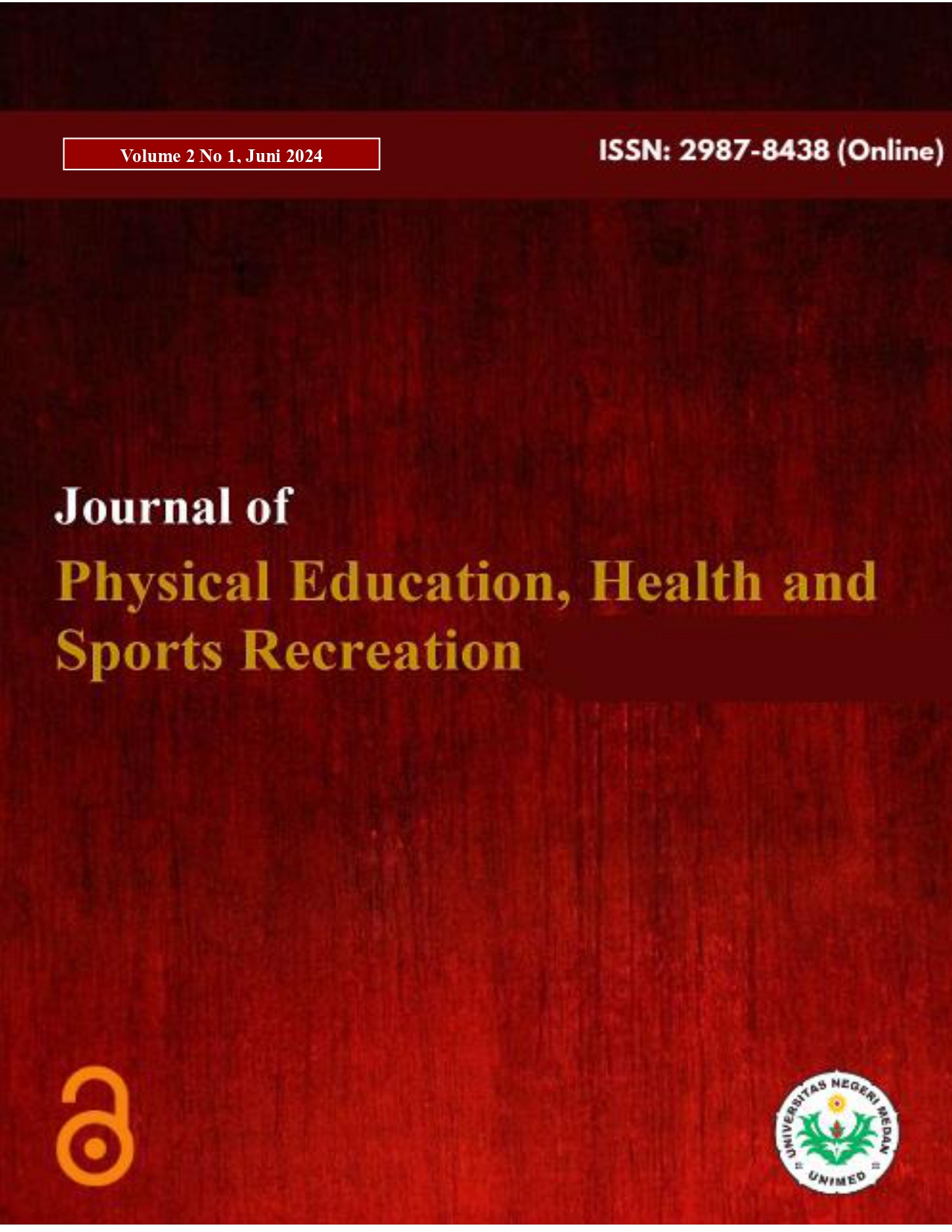DEVELOPMENT OF LEARNING MEDIA ON VOLLEYBALL UNDER PASSING TECHNIQUES USING E-MODULE MEDIA FOR CLASS VII JUNIOR HIGH SCHOOL STUDENTS
DOI:
https://doi.org/10.24114/jpehsr.v2i1.57146Keywords:
Development, E-Module, and Bottom Passing in VolleyballAbstract
This research is motivated by the fact that many volleyball underpassing lessons in schools are still conventional, as school learning activities are still teacher-centered. The objectives of this research are: To determine the feasibility of the Volleyball Bottom Passing E-Module Learning Media for junior high school students. This research uses a research and development model (Borg And Gall) using the ADDIE development model which includes (1) Research and Information Collecting (Preliminary Study), (2) Planning (Research Planning), (3) Develop Preliminary Form Of Product (Development Design), (4) Preliminary Field Testing (Preliminary/Limited Field Trial), (5) Main Product Revision (Main Product Revision/Limited Field Test Results) (6) Main Field Testing (Wider Product Trial) After media This learning was used in the implementation stage, learning media was declared suitable for use as teaching material in schools with an average material expert score of 3.7 and an average media expert score of 3.7, an average score of small group trials. amounted to 3.5 and students' response as users was 3.4 so the suitability of the learning media developed was in the "outstanding" category.References
Afriyanti, A., Darsi, H., & Sovensi, E. (2022). Analysis of the Difficulty in Performing the Volleyball Bottom Passing Technique at the Sahabat Muda Club Analisis Kesulitan Teknik Passing Bawah Bola Voli Pada Klub Sahabat Muda Volly Ball Lubuklinggau. 2(1), 31“38.
Alfaried, R. N., Rokhmawati, R. I., & Amalia, F. (2022). Pengembangan Modul Elektronik pada Pembelajaran Search Engine Marketing ( SEM ) dengan Metode Research and Development ( R & D ) ( Studi pada : SMK PGRI 3 Malang ). 6(4), 1728“1736.
Apriansyah, M. R. (2020). Pengembangan Media Pembelajaran Video Berbasis Animasi Mata Kuliah Ilmu Bahan Bangunan Di Program Studi Pendidikan Teknik Bangunan Fakultas Teknik Universitas Negeri Jakarta. Jurnal PenSil, 9(1), 9“18. https://doi.org/10.21009/jpensil.v9i1.12905
Arsal, M., Danial, M., & Hala, Y. (2019). Pengembangan Media Pembelajaran E-Modul Materi Sistem Peredaran Darah pada Kelas XI MIPA SMAN 6 Barru. Prosiding Seminar Nasional Biologi VI Harmonisasi Pembelajaran Biologi Pada Era Revolusi 4.0, 434“442.
Bandi, A. M. (2011). Pembentukan Karakter Anak Melalui Aktivitas Bermain Dalam Pendidikan Jasmani. Jurnal Pendidikan JAsmani Indonesia, 8(April), 2. https://scholar.google.com/scholar?cites=4695785154429841909&as_sdt=2005&sciodt=0,5&hl=en
Faozi, F., Sanusi, H., & Listiandi, A. D. (2019). Pengaruh Model Pembelajaran Kooperatif Tipe Stad Terhadap Keterampilan Passing Bawah Dalam Permainan Bola Voli Di SMA Islam Al-Fardiyatussa™adah Citepus Palabuhanratu. Physical Activity Journal, 1(1), 51. https://doi.org/10.20884/1.paju.2019.1.1.2001
Florentina Turnip, R., & Karyono, H. (2021). Pengembangan E-modul Matematika Dalam Meningkatkan Keterampilan Berpikir Kritis. Jurnal Edukasi Matematika Dan Sains), 9(2), 485“498. https://doi.org/10.25273/jems.v9i2.11057
Nindiasari, H., & Fatah, A. (2022). EDUKATIF : JURNAL ILMU PENDIDIKAN Integrasi Media Pembelajaran pada Penerapan Problem Based Learning ( PBL ) dalam Pembelajaran Matematika : Systematic Literature Review. 4(4), 5544“5557.
Qotimah, I., & Mulyadi, D. (2022). Kriteria Pengembangan E-Modul Interaktif dalam Pembelajaran Jarak Jauh. Indonesian Journal of Learning Education and Counseling, 4(2), 125“131.
Saputra, D. I. M., & Gusniar, G. (2019). Meningkatkan Hasil Belajar Passing Bawah Bola Voli melalui Bermain Melempar Bola. Gelanggang Olahraga: Jurnal Pendidikan Jasmani Dan Olahraga (JPJO), 3(1), 64“73. https://doi.org/10.31539/jpjo.v3i1.862
Satria, S., Pendit, D., Amelia, C., Pilok, N. A., Sitepu, M. S., Tadulako, U., Muhammadiyah, U., & Utara, S. (2022). PENGEMBANGAN E-MODUL DISCON BERBASIS ANDROID ( E-MODUL DISROID ) MATERI BUNYI BAGI SISWA SEKOLAH DASAR. 4(3), 175“191.
Siregar, H. M., Solfitri, T., & Anggraini, R. D. (2022). Analisis Kebutuhan Modul Kalkulus Integral ( Need Analysis of Integral Calculus Module To Improve. Jurnal Pendidikan Matematika, 05(01), 16“26.
Susilawati, Y., & Muhfahroyin, M. (2021). Analisis Pentingnya Pengembangan Modul Biologi Berbasis Potensi Lokal Dengan Mengintegrasikan Nilai-Nilai Keislaman. Biolova, 2(2), 103“107. https://doi.org/10.24127/biolova.v2i2.1150
Syarifudin, S. W. (2014). Pendidikan Jasmani dan Kesehatan, Olahraga, dan kesehatan (Vol. 1).
Tafonao, T. (2018). Peranan Media Pembelajaran Dalam Meningkatkan Minat Belajar Mahasiswa. Jurnal Komunikasi Pendidikan, 2(2), 103. https://doi.org/10.32585/jkp.v2i2.113
Widodo, S. A., & Wahyudin. (2018). Selection of learning media mathematics for Junior School Students. Turkish Online Journal of Educational Technology - TOJET, 17(1), 154“160. http://www.tojet.net/
Zakiyah, W. I., & Dwiningsih, K. (2021). Validitas E-modul Interaktif Sebagai Media Pembelajaran Untuk Melatihkan Kecerdasan Visual Spasial pada Materi Gaya Antar Molekul Validity of Interactive E-module as a Learning Media to Train Spatial Visual Intelligence on Intermolecular Force Materials. Prosiding Seminar Nasional Kimia, 243“240.
Downloads
Published
Issue
Section
License
Copyright (c) 2024 Journal of Physical Education, Health and Sports Recreation

This work is licensed under a Creative Commons Attribution-ShareAlike 4.0 International License.
Authors who publish with this journal agree to the following terms:
Authors retain copyright and grant the journal right of first publication with the work simultaneously licensed under a Creative Commons Attribution License that allows others to share the work with an acknowledgment of the work's authorship and initial publication in this journal.
Authors are able to enter into separate, additional contractual arrangements for the non-exclusive distribution of the journal's published version of the work (e.g., post it to an institutional repository or publish it in a book), with an acknowledgment of its initial publication in this journal.
Authors are permitted and encouraged to post their work online (e.g., in institutional repositories or on their website) prior to and during the submission process, as it can lead to productive exchanges, as well as earlier and greater citation of published work (See The Effect of Open Access).
This work is licensed under a Creative Commons Attribution-ShareAlike 4.0 International License.

